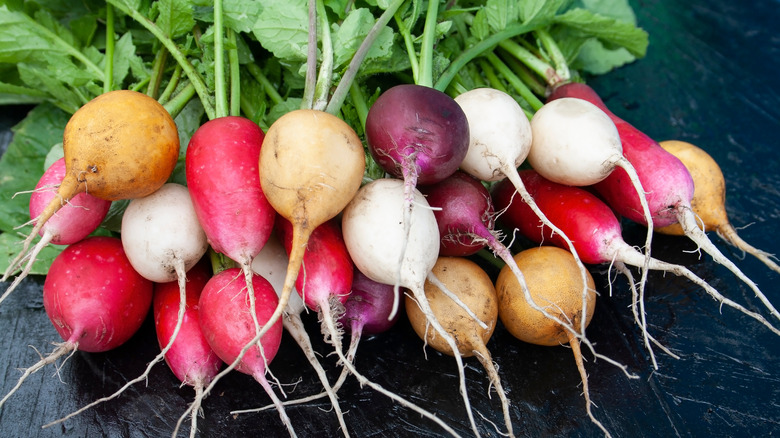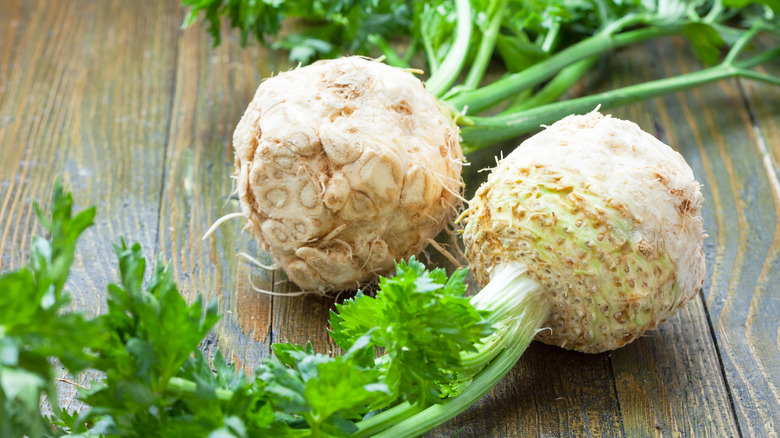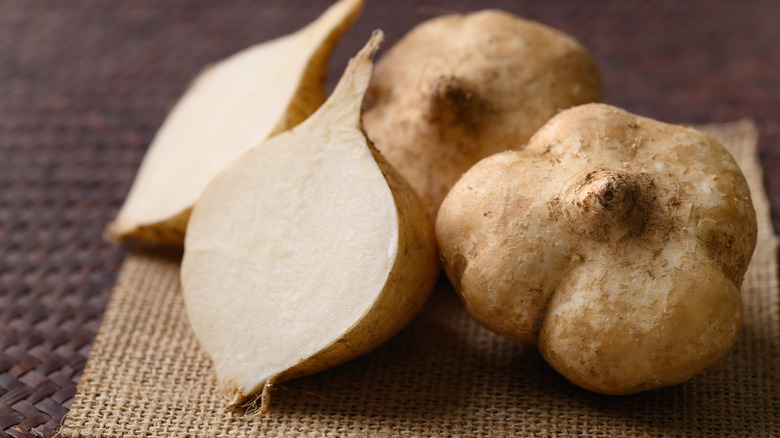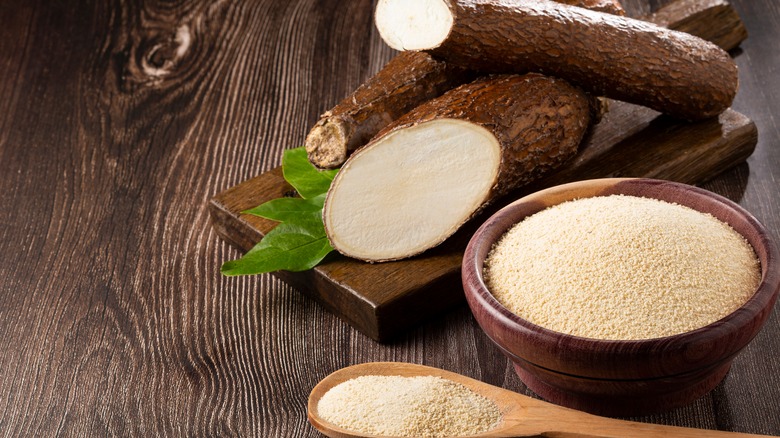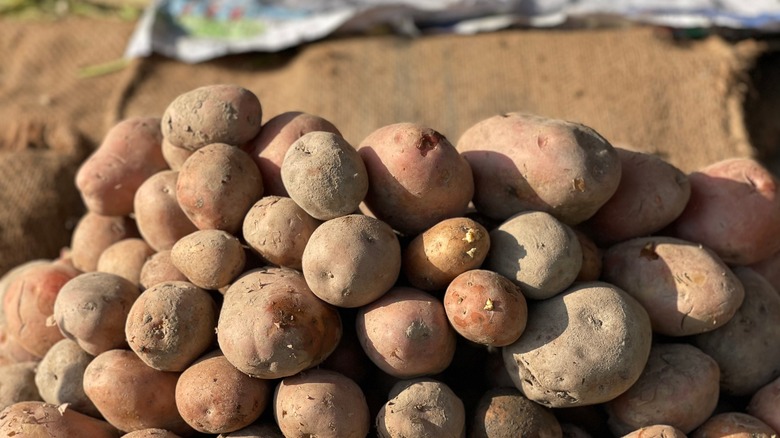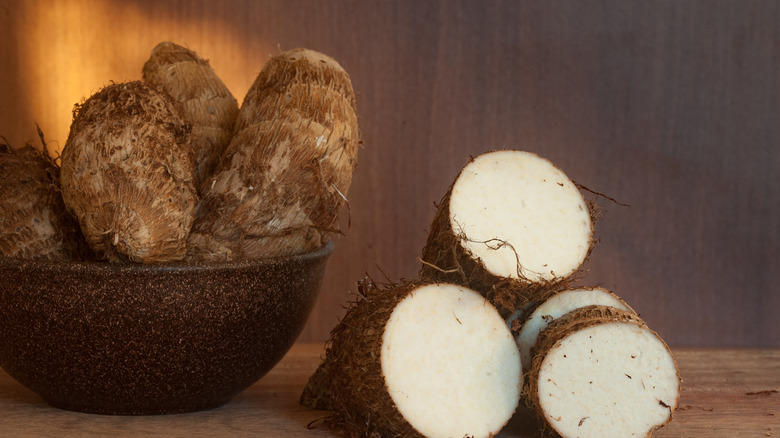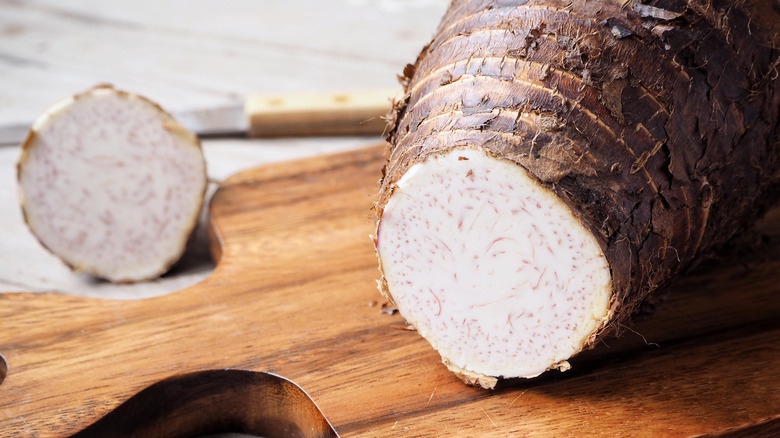23 Popular Root Veggies, Explained
Root vegetables get us through the winter, and all of the seasons, for that matter. They may look unassuming, often a bit dusty, round, and dense, but inside each root vegetable has a world of colors and flavors to show us. Furthermore, in places where the seasons are especially harsh and fresh fruits and vegetables were not historically available, root vegetables were a way to eat vegetables all year round. They store well through the winter and can be cooked in countless ways from mashes to colorful layered gratins. Whether you're interested in a cider-roasted root vegetable recipe or a miso-braised parsnip recipe, the versatility and nutritional appeal make it a no brainer for adding these ingredients to the shopping list.
Some root vegetables you may be familiar with and even devoted to. Others, though, you may never have heard of. So, from reading this list, we hope you will learn a thing or two not only about your favorite root vegetables, but also about vegetables and spices you never knew grew underground. The possibilities are endless when it comes to things that grow in our soil, and emerge like hidden gems from the ground.
Carrots
These orange, and sometimes purple, yellow, or white, beauties can be delightfully crunchy and flavorful. Carrots, which are delicious roasted, are also wonderful snacks and pair perfectly with a nice dip. On top of that, they are incredibly versatile and an undoubted kitchen staple because they make up the base flavors for many sauces, stews, and broths.
With one large taproot, which is the carrot that we all love, and many small roots that look like fine hairs, carrots gather all of the nutrients that they need to be sweet, crunchy, and tender from the soil that surrounds them.
Radishes
There are many varieties of radishes, like French breakfast and daikon, but you may be most familiar with the circular red radishes that are perfectly crunchy and fresh. With a naturally peppery kick, these root veggies are delicious in salads, roasted, or as a topping for tacos. Pickled radishes are also a classic treat and a great way to preserve any variety of radishes, especially if you have too many to eat in one sitting.
If you are looking for some other ways to store your radishes, try keeping them somewhere cool like your crisper drawer or in your basement. The low temperature will ensure that your radishes do not get mushy, and stay crispy for longer.
Onions
Another sauce and soup staple, onions are so incredibly versatile that they make up the base of many dishes around the world and can be found roasted, raw, pickled, fried, baked, you name it. These layered veggies, which are sweet and pungent, are also known for their ability to make people cry. But if you can get over the sting in your eyes onions are also a great source of fiber and vitamins like vitamin C.
No matter what occasion, you can always find a way to use onions. Something that makes it even easier to find an onion of your liking is the fact that there are many varieties and popular types of onions all with different colors, flavors, and level of sweetness.
Garlic
Eaten green and fresh, or more commonly found dry and cured, garlic is an irresistible aromatic that adds layers of savoriness to dishes. When roasted, garlic becomes deliciously nutty and soft in flavor, and when eaten raw, it is spicy and sharp. Garlic comes in a wide range of varieties and it is important to know how to store each kind to keep garlic fresh in order to prevent it from sprouting or shriveling.
Technically a vegetable, garlic grows underground in a fashion similar to onions, which are also part of the allium family. Both garlic and onions are grown underground and, once pulled, can be eaten fresh or left to dry, during which they develop layers of dry skin that they are known for.
Parsnips
The often-forgotten about cousin of the carrot, parsnips are most commonly white with a slightly thicker skin than the conventional carrot. These two root veggies may look similar, but carrots and parsnips have pretty distinct differences. Instead of the sweetness that carrots are known for, parsnips are spicier and more earthy tasting, making them a delicious addition to mashed potatoes (or really any kind of potatoes would work).
Another way to eat these often overlooked root veggies is by roasting them as a side dish or serving them in a gratin with lots of cheese to compliment their flavor.
Beets
Beautiful and bulbous, beats may stain your hands — and often your cutting board — but they are delicious nonetheless. With a truly distinctive earthly flavor and iconic flesh that is often a deep red and almost purple, beets are a nutritious and colorful addition to smoothies, salads, and dips.
Although you may be most familiar with red beets, they are also available in many other colors that can come out golden, striped, pink, and white. As with anything, it is important to know what to look for when buying beets to ensure that you will have the most delicious and perfectly ripe piece of produce. When in their prime, these root veggies can have striking color combinations which make beets wonderful garnishes and stunning centerpieces.
Turnips
Turnips look somewhat like radishes, except that they are often larger. Furthermore, rather than being small and bite-sized, turnips tend to be bulkier, and while they can sport splashes of color like purple top turnips, they are often white (think of Hakurai or Tokyo turnips).
A great thing about turnips — and many other plants that we have listed so far — is that you can eat both the root and the leaves. The root of the turnip, the turnip itself, is crunchy, slightly sweet, and quite refreshing, while the leaves can serve as a substitute for spinach or other braising greens.
Rutabaga
Rutabagas have a truly unique flavor that strongly deters some while drawing others in. These earthy and slightly bitter root vegetables are dense and quite difficult to cut into, but once you get through their thick skin, they are incredibly versatile. Delicious with turnips in a gratin or simply roasted until they are scrumptious and crispy, rutabagas are the ultimate winter veggie.
What may surprise you about this funny root vegetable is that it is actually a hybrid between turnips and cabbage, making it a child of two delicious and very versatile veggies. Rutabagas will bring a welcome heartiness to your meal and can even be great blended in soup. No matter how you eat them, you will be sure to taste their signature wintery flavor.
Celeriac
Celeriac has a similar flavor to rutabaga, but, as its name suggests, its flavor most closely resembles celery. This large bulb-like root veggie that can be found in the depths of winter, and while it is not actually the root of common celery, it is in the same family, and it, therefore, brings a lot of celery flavor to roasts and soups.
Celeriac, also known as a celery root, is also a great addition to mashes or root purée. Often highlighted in French cuisine, celeriac is an underrated root vegetable elsewhere. It has a distinctly celery-like flavor that brings some additional layers and flavor to any traditional root veggies dish.
Salsify
Another somewhat obscure root vegetable to many people, salsify is a member of the dandelion family and originates from the Mediterranean. Its leaves are also edible, but you will probably only encounter it in its root form, which can be either white or black.
Salsify season, which, according to the BBC, falls from October to January, makes it a perfect winter vegetable. It stores well in a cool place, and also makes wonderfully comforting dishes. To prepare this funny root, you can simply wash and peel it and then simmer or sauté the pieces. Get familiar and benefit your recipe collection by learning how to cook with salsify. We suggest adding it to a nice warm veggie stew.
Turmeric
Turmeric is a magical spice, and, in fact, it not only dyes foods a stunning shade of gold but is also filled with nutrients that will help you fight off your next cold. This spice, which is most commonly found in its dry powder form, actually grows underground and comes out looking somewhat like a mix between a caterpillar and ginger.
You can use turmeric either dry or fresh, but, as with any dry spice, its shelf life is much longer in its dry version. However, the flavor of this spice also changes as it ages, so if you are looking for fresh and spicy, make sure to locate some turmeric in its root form.
Ginger
Ginger comes in many varieties, each with its own purpose and benefits. Some ginger is best used to flavor dishes, while others are most delicious pickled or in tea. Regardless, ginger is a wonderfully beloved aromatic that has a place in every kitchen.
Also available fresh or dried, the different versions of ginger root are very dependent on what you are using them for. Fresh ginger is essential for bringing vibrant flavor to foods, while dried ginger does a fantastic job of adding layers of comforting spice. That is why favorites like pumpkin pie and gingersnap cookies are so amazing.
Jerusalem artichokes
These funny little nubs will totally surprise you with their creaminess and richness. While they do not look like much on the outside, below their dry, golden brown skin, Jerusalem artichokes are absolutely delectable and are an underrated veggie.
Also known as sunchokes, these root veggies can be a great substitute for potatoes because they mash and crisp up in similar ways, but also bring their own unique flavor to the table. The taste of Jerusalem artichokes is much nuttier than many other root vegetables, and this veggie pairs wonderfully with crunchier dishes, as their creaminess will balance out any crunch.
Jicama
Jicama is the perfect summer snack, especially when loaded with Tajin and lime juice. Alone, it has a flavor that almost resembles water, and it's so mild it doesn't taste like much. But that makes it a great vehicle for other flavors and also a scrumptiously crunchy snack.
Try adding jicama to your salads and slaws for a much-appreciated crunch. While it only grows in tropical climates, it can still be found in many grocery stores across the U.S. This veggie is also known for its toughness, so if you do find some jicama, make sure to take care when cutting into its dense shape.
Bamboo shoots
Only available in springtime, and best eaten hours after harvest, fresh bamboo shoots are near impossible to find in the U.S. However, due to their alluring texture, flavor, and very interesting interior pattern, they can be found in vacuum-packed bags or cans in many stores if you know where to look.
The reason bamboo shoots are difficult to find fresh is that they grow in very specific conditions and do not have a long fresh shelf life. Fresh shoots spring off from the mother plants each year and bud underground around the existing colony until they are either harvested or sprout through the surface.
Peanuts
Peanuts are beloved for their creaminess, flavor, oil, and crunchiness. But do you know how they grow? Unlike their name, peanuts actually grow below ground in a manner similar to potatoes. Technically considered a legume, peanuts grow underground fanning out from the main stem, attached by thin little roots that hold them to the mother plant.
When peanuts are first harvested, they contain quite a bit of moisture, which makes sense since they are coming out of the ground. Once they are above ground, they must be dried to ensure that they will be shelf stable and transform into the snack we love.
Horseradish
Horseradish is known for its spiciness and sometimes overwhelming nasal-clearing abilities. However, the key to working with horseradish is knowing how to handle it. When you grate horseradish, you are releasing its oils that then react to create its iconic spiciness. In order to limit the spiciness of your grated horseradish, try adding vinegar to counteract the reaction. Learning how to properly prepare fresh horseradish will make the most out of your experience with the ingredient.
Horseradish pairs wonderfully with other mild flavors, and you can use this flavorful root to make great sauces. In fact, horseradish, not surprisingly, pairs well with other strong flavors, like horseradish mustard, which can be made to mellow out the horseradish's natural spiciness.
Yuca
A delightfully starchy root vegetable, yuca, also known as manioc or cassava, is a staple vegetable in many parts of the world and the base root for tapioca. Yuca has a mild flavor that lends itself well to acid, sugar, and fat, making it versatile and irresistible. This is part of the reason it is a staple vegetable in many parts of the world.
On top of that, yuca has a natural chew to it, which can be felt in the bounciness of tapioca balls and cheesy pao de quejio. This chew makes yuca oh-so-tasty and satisfying to eat.
Potatoes
Beloved and versatile, the potato is another staple starch around the world that grows underground. With so many potato varieties available, it can be overwhelming when trying to figure out which type of potato to use for which dish, but, in general, they are all delicious.
If you are a devout potato fan but don't know how to prepare these delicious gems from the earth, look no further. For your next homey meal, try making some crispy potatoes, and, if those are not decadent enough, you can never, ever go wrong with classic scalloped potatoes loaded with cheese and seasonings.
Sweet potatoes
Sweet, silky, creamy, and smooth; sweet potatoes have it all. They are starchy and satisfying, make great pies (although not better than pumpkin), and are the perfect side dish for any fall meal. On top of that, sweet potatoes store very well for long periods of time and have an addicting natural sweetness that pairs beautifully with spices, herbs, and other root veggies.
When shopping, make sure to avoid buying sweet potatoes with lots of bruises. This can indicate that they were harmed during transport and that their flesh may not be as soft or flavorful when you go to eat them. However, if you do find yourself with a bruised sweet potato, simply cut off the bruised part and enjoy it regardless.
Yams
Yams and sweet potatoes are often talked about interchangeably, but they are actually quite different. The difference between yams and sweet potatoes is in their etymology. Yams originate from West Africa where they are known as nyami, nyam, or enyame, and to this day have a strong importance in African and African-American cuisine.
Yams can grow up to 45 feet long and have a flavor and texture that is fairly similar to yuca or potatoes. This makes them another deliciously starchy and versatile root vegetable, not to mention a quite large one. You can cook your yams as you would potatoes, making them into a mash, or simply roasting them to bring out their natural flavor.
Taro
If you have ever seen the purple wisps of hair and fiber that trickle through the inside of the taro root, perhaps you have also appreciated its simple beauty. On top of that, this root is greatly important in many cuisines. A staple in Malaysian, Hawaiian, and Puerto Rican dishes to name a few, taro has a starchy and nutty flavor that pairs well with meat and veggies.
To cook up taro in your next meal, you simply must peel its tough skin and then cook it as you would any other starchy root. It has a delightful natural sweetness that makes great ice cream (or taro milk tea), and also holds up well after long periods of simmering.
Lotus roots
Another absolutely stunning root vegetable, lotus roots are interesting because, while they are technically roots, they grow in water as, you guessed it, the root of a lotus plant. They actually grow vertically downward in the water.
Due to their aquatic nature, they require a large amount of water to be grown, making them difficult to grow in dry climates. Do not fear, though, as you can still easily find lotus roots frozen or canned, and, if you are lucky, you may even find them in their chip form, which is crunchy and delicious. Having a can on hand also makes for an easy ingredient for simple meals, such as a lotus root stir-fry.
Static Media owns and operates Mashed.


